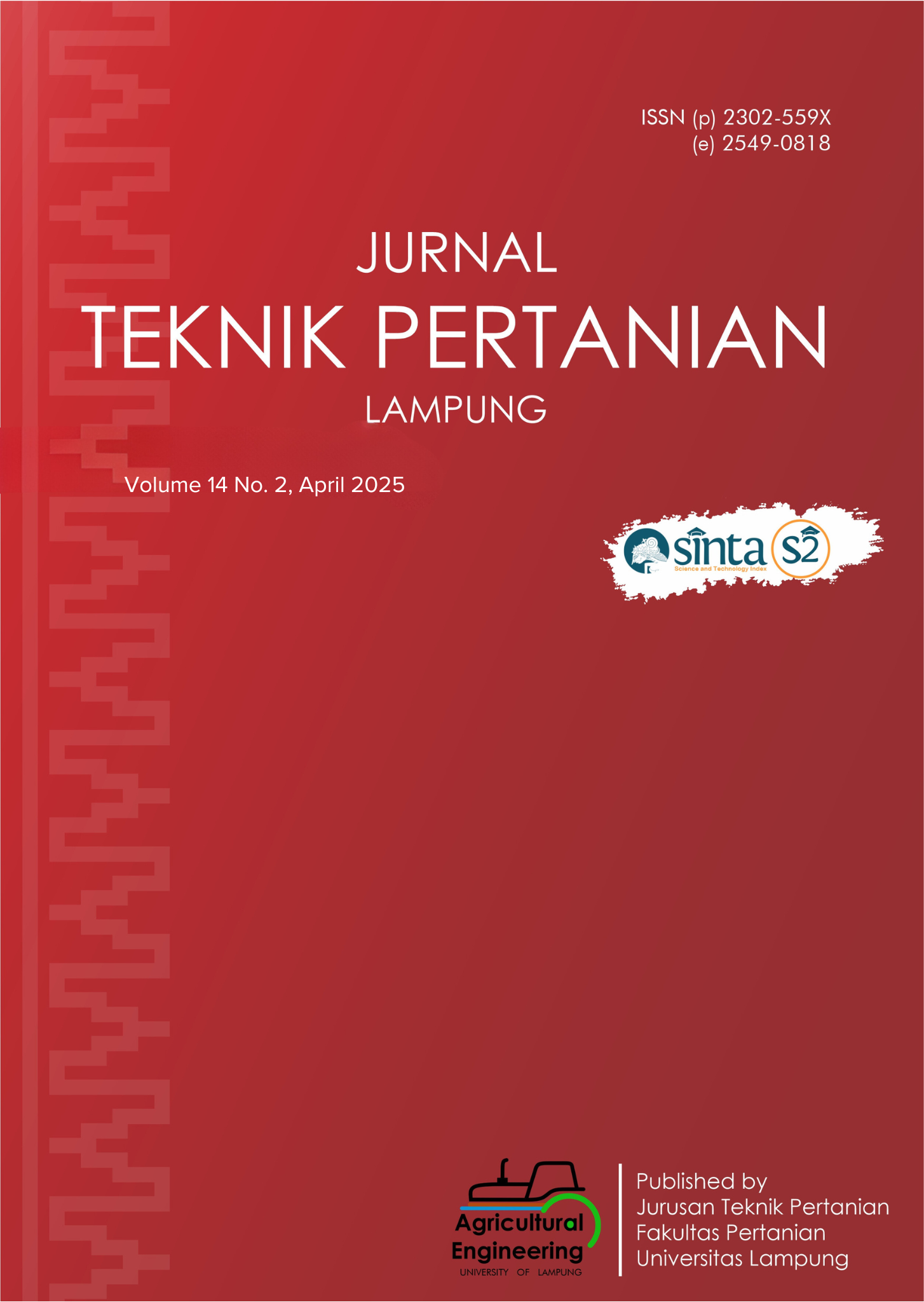Effect of Rice Husk Bioactive Compost Charcoal Application on the Agronomic Characteristics of Peanut (Arachis hypogaea L.) on Alluvial Soil
DOI:
https://doi.org/10.23960/jtep-l.v14i2.372-379 Abstract View: 241
Abstract View: 241
Abstract
Peanut production on alluvial soil faced challenges due to low soil fertility. The application of soil amendments such as bioactive compost charcoal (BCC) was necessary to improve alluvial soil fertility. The aim of the study was to assess the effect of rice husk BCC application on the agronomic characteristics of peanut in alluvial soil. The research was conducted using a Completely Randomized Design (CRD) and analyzed using the F-test and Tukey's test at 5% significance level. The study design included 4 samples and 6 treatment levels: d1 (20 g/polybag), d2 (40 g/polybag), d3 (60 g/polybag), d4 (80 g/polybag), d5 (100 g/polybag), and d6 (120 g/polybag). The observation variables included plant height, number of branches, number of pods, pod wet weight per plant, and pod dry weight per plant. The data analysis results showed that the application of BCC had a significant effect on the agronomic characteristics of the peanut plants. The application of BCC at a dose of 120 g/polybag showed the best results and was recommended for use on alluvial soil with crop yield of of 31.72 g fresh pod or 24.86 g dry pod weight.
Keywords: Agronomic characteristics, Alluvial soil, Bioactive compost charcoal, Peanut, Rice husk.
Downloads
References
Agegnehu, G., Bass, A.M., Nelson, P.N., & Bird, M.I. (2016). Benefits of biochar, compost and biochar-compost for soil quality,
maize yield and greenhouse gas emissions in a tropical agricultural soil. Science of the Total Environment, 543, 295–306.
https://doi.org/10.1016/j.scitotenv.2015.11.054
Agegnehu, G., Bass, A.M., Nelson, P.N., Muirhead, B., Wright, G., & Bird, M.I. (2015). Biochar and biochar-compost as soil
amendments: effects on peanut yield, soil properties and greenhouse gas emissions in tropical North Queensland, Australia.
Agriculture, Ecosystems & Environment, 213, 72-85. https://doi.org/10.1016/J.AGEE.2015.07.027
Alarefee, H.A., Ishak, C.F., Karam, D.S., & Othman, R. (2021). Efficiency of rice husk biochar with poultry litter co-composts in
oxisols for improving soil physico-chemical properties and enhancing maize performance. Agronomy, 11(12), 2409.
https://doi.org/10.3390/agronomy11122409
Ali, M., Ahmed, O.H., Jalloh, M.B., Primus, W.C., Musah, AA., & Ng, J.F. (2023). Co-composted chicken litter biochar increases soil nutrient availability and yield of Oryza sativa L. Land, 12(1), 233. https://doi.org/10.3390/land12010233
Antonangelo, J.A., Sun, X., & Zhang, H. (2021). The roles of co-composted biochar (COMBI) in improving soil quality, crop productivity, and toxic metal amelioration. Journal of Environmental Management, 277, 111443. https://doi.org/10.1016/j.jenvman.2020.111443
Asadi, H., Ghorbani, M., Rezaei-Rashti, M., Abrishamkesh, S., Amirahmadi, E., Chengrong, C., & Gorji, M. (2021). Application of rice husk biochar for achieving sustainable agriculture and environment. Rice Science, 28(4), 325–343. https://doi.org/10.1016/j.rsci.2021.05.004
BPS (Badan Pusat Statistik). (2016). Kalimanatan Barat dalam Angka. Badan Pusat Statistik Provinsi Kalimantan Barat.
Barrow, N.J., & Hartemink, A.E. (2023). The effects of pH on nutrient availability depend on both soils and plants. Plant Soil, 487, 21–37. https://doi.org/10.1007/s11104-023-05960-5
Chen, W., Teng, Y., Li, Z., Liu, W., Ren, W., Luo, Y., & Christie, P. (2018). Mechanisms by which organic fertilizer and effective microbes mitigate peanut continuous cropping yield constraints in a red soil of south China. Applied Soil Ecology, 128, 23-34. https://doi.org/10.1016/J.APSOIL.2018.03.018
Dhaliwal H.S., Brar, Y.S., & Brar, G.S. (2022). Evaluation of pollutants emitted from open field crop residue burning in Punjab, India. In: Kumar, R., Pandey, A.K., Sharma, R.K. (editors). Recent Trends in Thermal Engineering. Springer, Singapore: 203–211. https://doi.org/10.1007/978-981-16-3132-0_20
Diallo, M.D., Wood, S.A., Diallo, A., Mahatma-Saleh, M., Ndiaye, O., Tine, A.K., Ngamb, T., Guisse, M., Seck, S., Diop, A., & Guisse, A. (2015). Soil suitability for the production of rice, groundnut, and cassava in the peri-urban Niayes zone, Senegal. Soil and Tillage Research, 155, 412-420. https://doi.org/10.1016/j.still.2015.09.009
Direktorat Jenderal Tanaman Pangan. (2024). Laporan Tahun 2023. Direktorat Jenderal Tanaman Pangan, Kementerian Pertanian, Jakarta. https://tanamanpangan.pertanian.go.id/assets/front/uploads/document/LAPORAN%20TAHUNAN%202023.pdf
Gao, S., Harrison, B.P., Thao, T., Gonzales, M.L., An, D., Ghezzehei, T.A., Diaz, G., & Ryals, R.A. (2023). Biochar co-compost improves nitrogen retention and reduces carbon emissions in a winter wheat cropping system. GCB Bioenergy, 15(4), 462–477. https://doi.org/10.1111/gcbb.13028
Görl, J., Lohr, D., Meinken, E., & Hülsbergen, K.J. (2023). Co-composting of hop bines and wood-based biochar: Effects on composting and plant growth in copper-contaminated soils. Agronomy, 13(12), 3065. https://doi.org/10.3390/agronomy13123065
Herman, W., & Resigia, E. (2018). Pemanfaatan biochar sekam dan kompos jerami padi terhadap pertumbuhan dan produksi padi (Oryza sativa) pada tanah ordo ultisol. Jurnal Ilmiah Pertanian, 15(1), 42-50.
Menteri Pertanian. (2019). Keputusan Menteri Pertanian No. 261/KPTS/SR.310/M/4/2019 tentang Persyaratan Teknis Minimal Pupuk Organik, Pupuk Hayati, dan Pembenah Tanah. Menteri Pertanian Republik Indonesia.
Kizito, S., Luo, H., Lu, J., Bah, H., Dong, R., & Wu, S. (2019). Role of nutrient-enriched biochar as a soil amendment during maize growth: Exploring practical alternatives to recycle agricultural residuals and to reduce chemical fertilizer demand. Sustainability, 11. https://doi.org/10.3390/su11113211
Kögel-Knabner, I., & Amelung, W. (2021). Soil organic matter in major pedogenic soil groups. Geoderma, 384, 114785. https://doi.org/10.1016/j.geoderma.2020.114785
Li, Z., Zheng, Z., Li, H., Xu, D., Li, X., Xiang, L., Tu, S. (2023). Review on rice husk biochar as an adsorbent for soil and water remediation. Plants, 12, 1524. https://doi.org/10.3390/plants12071524
Manurung, R., Gunawan, J., Hazriani, R., & Suharmoko, J. (2017). Pemetaan status unsur hara N, P dan K tanah pada perkebunan kelapa sawit di lahan gambut. Jurnal Pedon Tropika, 3(1), 89-96.
Mondal, M., Skalický, M., Garai, S., Hossain, A., Sarkar, S., Banerjee, H., Kundu, R., Brestič, M., Barutçular, C., Erman, M., Sabagh, A., & Laing, A. (2020). Supplementing nitrogen in combination with rhizobium inoculation and soil mulch in peanut (Arachis hypogaea L.) production system: Part II. Effect on phenology, growth, yield attributes, pod quality, profitability and nitrogen use efficiency. Agronomy, 10, 1513. https://doi.org/10.3390/agronomy10101513
Nurida, N.L., & Jubaedah. (2022). Co-compost biochar as a soil ameliorant: Improvement of soil chemical characteristics and maize yield in Ultisol. IOP Conference Series: Earth and Environmental Science, 1114, 012046. https://doi.org/10.1088/1755-1315/1114/1/012046
Penn, C.J., & Camberato, J.J. (2019). A critical review on soil chemical processes that control how soil pH affects phosphorus availability to plants. Agriculture, 9, 120. ttps://doi.org/10.3390/agriculture9060120
Sharma, V., Irmak, S., & Padhi, J. (2018). Effects of cover crops on soil quality: Part II. Soil exchangeable bases (potassium, magnesium, sodium, and calcium), cation exchange capacity, and soil micronutrients (zinc, manganese, iron, copper, and boron). Journal of Soil and Water Conservation, 73(6), 652-668.
Shifa, S., Worku, M., & Beyene, A. (2024). Co-application of compost and biochar improves soil properties and Desho grass growth on acidic soils in a tropical environment of Southwestern Ethiopia. Cogent Food and Agriculture, 10(1), Article 2290338. https://doi.org/10.1080/23311932.2023.2290338
Singh, S.P., Dutta, S., Jha, S., Prasad, S.S., Chaudhary, S.K., Manna, M.C., Majumdar, K., Srivastava, P., Brahmanand, P.S., Singh, K.M., & Kumar, K. (2022). Indigenous nutrient supplying capacity of young alluvial calcareous soils favours the sustainable productivity of hybrid rice and maize crops. Sustainability, 14, 11585. https://doi.org/10.3390/su141811585
Sulaeman, S., Suparto, S., & Eviati, E. (2009). Analisis Kimia Tanah, Tanaman, Air, dan Pupuk. Balai Penelitian Tanah, Badan Penelitian dan Pengembangan Pertanian, Departemen Pertanian, Bogor: 136 p.
Suyanto, A., Masulili, A., Youlla, D., Setiawan, & Tamtomo, F. (2019). The study of utilization of coconut shell compost (ARKOBA) to increase the growth and yield of rice (Oryza sativa L.) in West Kalimantan. Advances in Social Science, Education and Humanities Research, 6th International Conference on Community Development, 349, 23-26.
Teodoro, M., Trakal, L., Gallagher, B.N., Šimek, P., Soudek, P., Pohořelý, M., Beesley, L., Jačka, L., Kovář, M., Seyedsadr, S., & Mohan, D. (2020). Application of co-composted biochar significantly improved plant-growth relevant physical/chemical properties of a metal contaminated soil. Chemosphere, 242, 125255. https://doi.org/10.1016/j.chemosphere.2019.125255
Trupiano, D., Cocozza, C., Baronti, S., Amendola, C., Vaccari, F.P., Lustrato, G., di Lonardo, S., Fantasma, F., Tognetti, R., & Scippa, G.S. (2017). The effects of biochar and its combination with compost on lettuce (Lactuca sativa L.) growth, soil properties, and soil microbial activity and abundance. International Journal of Agronomy, 2017, 3158207. https://doi.org/10.1155/2017/3158207
Xie, M., Wang, Z., Xu, X., Zheng, X., Liu, H., & Shi, P. (2020). Quantitative estimation of the nutrient uptake requirements of peanut. Agronomy, 10(1), 119. https://doi.org/10.3390/agronomy10010119
Downloads
Published
How to Cite
Issue
Section
License
Authors who publish with this journal agree to the following terms:
Authors retain copyright and grant the journal right of first publication with the work simultaneously licensed under a Creative Commons Attribution-ShareAlike 4.0 International Lice that allows others to share the work with an acknowledgement of the work's authorship and initial publication in this journal.
Authors are able to enter into separate, additional contractual arrangements for the non-exclusive distribution of the journal's published version of the work (e.g., post it to an institutional repository or publish it in a book), with an acknowledgement of its initial publication in this journal.
Authors are permitted and encouraged to post their work online (e.g., in institutional repositories or on their website) prior to and during the submission process, as it can lead to productive exchanges, as well as earlier and greater citation of published work (See The Effect of Open Access).
Jurnal Teknik Pertanian Lampung

JTEPL is licensed under a Creative Commons Attribution-ShareAlike 4.0 International License.













